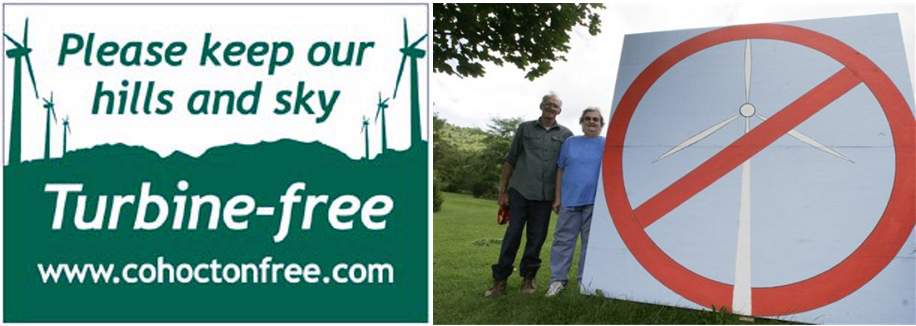Landscape Values and Social Acceptance
Consider:
Are people attached to the urban landscape in the same way as they are to mountain ridgelines or ocean horizons?
“Resource extraction in the case of fossil or nuclear energy happens below the earth’s surface and is thus invisible for everyday life of a citizen, while wind turbines…harness energy in a more visible way.”
Wüstenhagen, Wolsink, and Bürer. “Social acceptance of renewable energy innovation: An introduction to the concept.” 2007 (1)

Photo credits: Cohocton Free! (left), Associated Press (right)
The recent growth in wind power in “rural” areas has not been without controversy at a local level. A growing body of literature investigates the variety of objections raised to wind power projects, but each objection seems to involve a sense of lost control over the landscape.
While some concerns (chiefly noise) can - in theory - be measured, others are not so easily quantified. Opinions about interventions in the landscape are hardened by a fear of landscape change at an individual as well as societal level. On an individual level, we have strong connections to places as they exist in our memory (Righter 2002), and these personal remembrances are moderated by competing cultural landscape narratives and stories (Marx 1967). Whether wind turbines are seen as monstrous intrusions in the landscape or as beautiful sculptural objects depends on a variety of factors specific to the observer, including one’s personal preference, one’s proximity to the location in question and one’s previous exposure to wind turbines. There is some evidence that community ownership of wind energy facilities can also be a strong factor in increasing local acceptance (Bolinger 2001; Maruyama 2007).
Different combinations of these factors seems to have played a role in each of the case studies.
Sources:
1) Wüstenhagen, Rolf, Martin Wolsink, and Mary Jean Bürer. “Social acceptance of renewable energy innovation: An introduction to the concept.” Energy Policy. Kidlington: May 2007. Vol. 35, Iss. 5; p. 2683.
2) Righter, Robert. "Exoskeletal Outerspace Creations." in Pasqualetti, Martin J., Paul Gipe, and Robert W. Righter. Wind Power in View: Energy Landscapes in a Crowded World. San Diego: Academic Press, 2002.
3) Marx, Leo. The Machine in the Garden: Technology and the Pastoral Ideal in America. London: Oxford University Press, 1967.
4) Bolinger, Mark. “Community Wind Power Ownership Schemes in Europe and their Relevance to the United States.” Berkeley: Lawrence Berkeley National Laboratory, 2001. <http://eetd.lbl.gov/EA/EMP/re-pubs.html>
5) Maruyama, Y., Nishikido, M., Iida, T., “Wind power and society interaction in Japan: along the rise of community wind power.” Energy Policy. Kidlington: May 2007. Vol. 35, Iss. 5; p. 2761.
